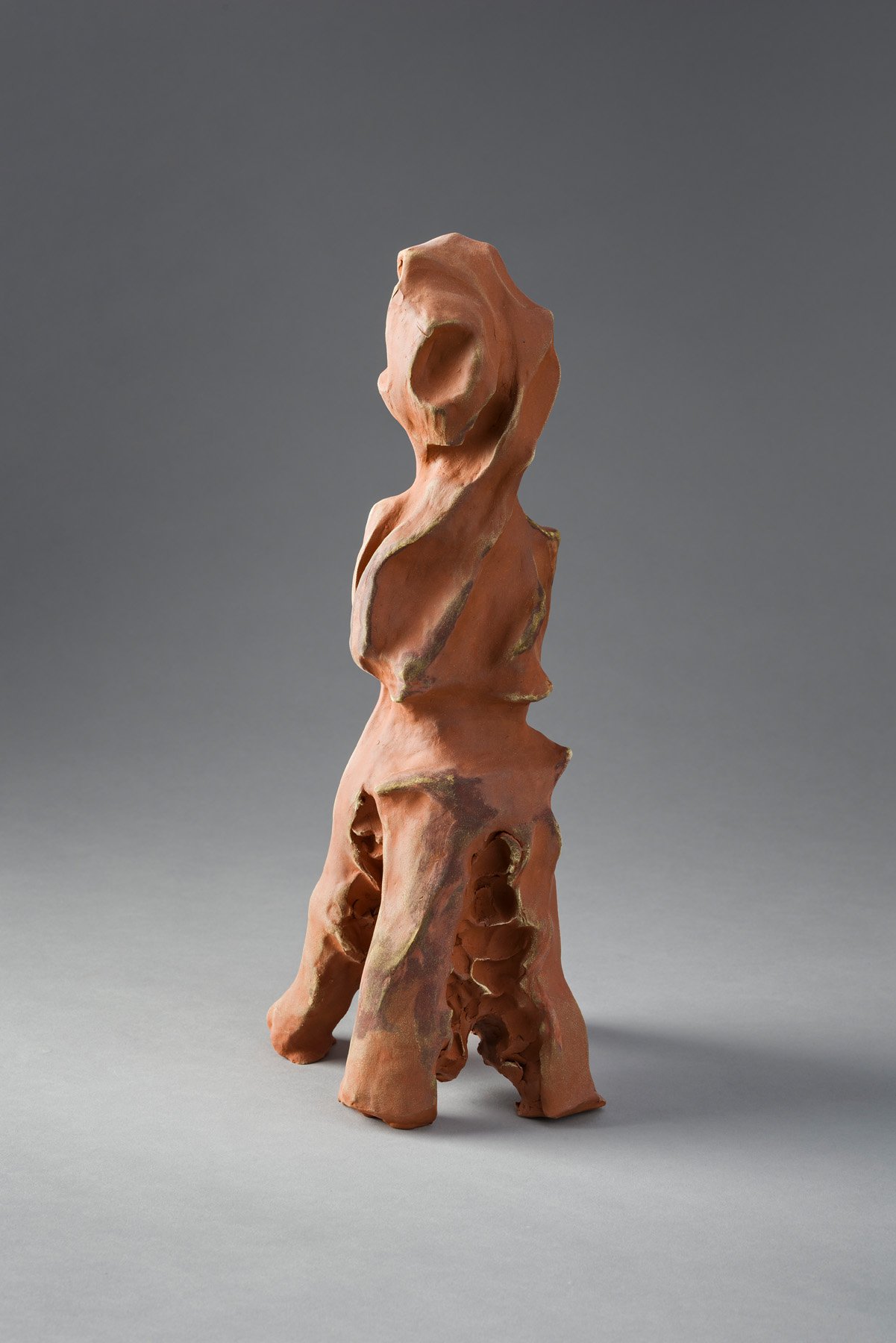On Surface Decoration and the Human Touch
Reflections on the threading touches behind the work at Body Vessel Clay: Black Women, Ceramics and Contemporary Art at Two Temple Place.
Clay and touch. A symbiosis.
As touch shapes clay.
Clay touch heals.
As touch gives clay meaning.
Clay touch gives us reasons for being.
Time. Caring. Shaping.
Either the shaping of the clay molecules to turn a lump of soil into a vessel.
Or the shaping of neurological pathways via the nerve-endings in our fingertips.
Relaxing the mind as the hand, relaxedly, shapes.
Ladi Kwali translated her own body marks and tattoos as well as local cosmologies and iconographies into surface decoration.
Lizards, arrows, lines, curves, geometrical figures.
Lots can be imagined about what those might mean. But as curator Dr. Jareh Das once said, who are we to project meaning onto them? We just don’t know.
Magdalene Odundo was inspired by Ladi Kwali’s markings and came up with her own. On some of Magdalene’s vessels in the first room, we also see the lines and marks that appear on the surface of the vessels as it is turned with a metal tool - I assume - and the sand and stones in the clay body move, scratching the surface. Marks that I love and can also be seen on my Water Jug and Womb Vessel.
Magdalene Odundo
Magdalene Odundo
Bisila Noha, Water Jug
With time and work, Magdalene found her voice. Slips and burnishing turning the surfaces of her pots into wonders of pottery.
The repeated touch of the burnishing stone elevating the essence of the clay.
Smooth, shiny.
This can also be seen - in a less refined and mastered way - on my Reunion pieces.
The touch of stones I got in Morocco while learning from Mama Aicha, who would make us burnish for hours. We didn’t enjoy it - at all - and made jokes about our commitment to not burnish ever again. And yet, I asked Mama Aicha to approve the stones that I was collecting to take home with me.
Reunion pieces and Dancing Goddess
Dancing Goddess
If one compares the surface of the Dancing Goddess and the Reunion pieces, one can see that the latter are smooth, shinier and the colour of the clay uniform.
These are burnished.
Meanwhile, the former shows different hues. Wherever I manipulated the clay more, it looks burnt. Over cooked. Did I touch it too much?
Once again, fire telling us things about the way a vessel has been made. About our own way of touching.
‘Listening carefully, whatever wants to come out comes out.
What I want to come out never comes out.'
Eduardo Chillida
Creativity is such a personal language and process. However, we tend to insist on looking around us to understand our own creative processes. At least that’s what I used to do.
Thinking of the pieces I wanted to make for Body Vessel Clay, I started drawing.
Rather terribly.
Sketches on paper of intellectualised shapes. The brain ruling the process.
I felt very distant from those drawings; from those shapes - supposedly - of mine.
And then I met multidisciplinary artist Marcia Michael. She generously invited me to her house to feed me and show me her very first clay pieces. Works she had made during the first lockdown with no previous knowledge of clay.
Even before going I was honoured. I was a fan of Marcia’s work - which I had seen at Autograph in 2018 - and thanks to the Internet she had found me and got in touch.
So I went.
Of course.
And what I saw was exactly what I needed to see.
I was just at the very beginning of seriously getting on with making the pieces for Body Vessel Clay, after months of play and exploration, working with plaster and metal; having fun. I don’t know what I would have made if I hadn’t visited Marcia. That day I saw what I had been dreaming of - even if I didn't know it.
The honest and intuitive way in which Marcia had touched and shaped the clay to make the shapes her ancestors had asked her to make, filled my heart with joy, possibility and hope.
The hours I spent with Marcia undoubtedly are some of the best of my life.
Listening to her dreams, her story, the extraordinary way in which she is tuned in to her subconscious. Introducing me to her ancestors.
Another mother, grandmother, from whom I was learning. I am still humbled by her willingness to share it all with me.
When I left her house, I cycled back to the studio as fast as I possibly could. I opened a bag of porcelain. And I just made.
No thoughts. No pretensions.
Just my hands and the clay.
Touching, feeling, shaping.
Studies in porcelain
The little figurines I made were exactly what I wanted to make.
Magical.
Since then, every day at the studio I would start by making some figurines.
Whatever came out, came out.
No judgement.
Studies in porcelain
Those little goddesses of mine guided my creative process. They taught me how my fingers wanted to move.
How they wanted to shape the clay. What it was that I wanted to create.
‘Only when [s]he no longer knows what [s]he is doing,
does the painter do good things’
Edgar Degas
The way of touching I learnt and embodied while playing with those figures informed the shapes, the curves, the waves, the holes, the scratches in the Reunion pieces. The intention of the Dancing Goddess.
They are the driving force behind this body of work. The lighthouse that kept directing the vessels to my subconscious. To my dreams. Without me even noticing.
‘I have yesterday’s hands,
I’m missing tomorrow’s.’
Eduardo Chillida
As the exhibition continues, touch remains the thread.
Jade Montserrat and Julia Phillips’ performances bring touch, the body and the land together. Jade’s performance for camera Clay (2015) takes touch and the bodily connection to clay to a whole new level as she digs a pit of clay and covers her body with it. She explores the notion of belonging and unbelonging, drawing from her experience living in North Yorkshire. While clay is everywhere and is, to me, the common thread of our universal shared history, access to land and nature have become the strongholds of power, which has had an impact on our bodily connection to those and, as a result, on our own sense of identity and belonging.
Seeing Jade cake her body in clay, reclaiming the land, her herstory, place in the world and power, made me feel more connected. Both to the land - physically and metaphorically -, and also to the clay I work with.
Julia Phillips continues this conversation as she stomps into clay, bare foot, dancing. Confidently, violently, with great purpose, as a growing pile of clay is thrown into the frame.
Jade Monserrat
The beauty that results from the violent interaction between the body and the clay that is palpable in Julia’s performance can also be felt in Vivian Chinasa Ezugha’s performance Uro. Six hours of uninterrupted interaction between Chinasa’s own body and the clay. Touching it, carrying it and throwing it into a pile that was then turned into a sculpture, also exhibited at the show.
Vivian Chinasa Ezugha
I have always loved the deep connection that exists between clay and life’s creation and end. Christianity, Judaism and Islam; Chinese, pre-Columbian, Ancient Egyptian and Greek mythologies, as well as traditions in African cultures, in New Zealand and all around the globe, have all used clay to explain the beginning of life. In some places, pots would be made when someone is born and broken when someone dies. We are the soil we stand on.
And so, I could only but admire the intimate way in which Chinasa explores the concepts of birth and death in her performance. Exerting herself to the point of wanting to stop the performance, to give up. Instead, she continued for six hours to embody that process of death and rebirth; with all the pain and weakness that stems from that process of deconstruction, of rebirth.
‘I thought about this process of dying and rebirth, and the idea that you can be made from clay when you die you go back to clay, but at the same time surely within that process there is also a rebirth that should happen.
The clay should be able to renew the self and be used to create another self’
Vivian Chinasa Ezugha
Identity, belonging, bodies, our connection to our environment and how our bodies interact with the clay are also explored by Shawanda Corbett and Phoebe Collings-James.
Shawanda’s practice combines performance and sculpture to raise questions such as ‘what is a complete body?’, and consequently, ‘what is a complete vessel?’ The vessels from the series Candy Lady (2020), for instance, were painted as Shawanda danced to ‘Part 3: Pursuance’ by John Coltrane. Her interaction with the vessels is a result of her interaction with her environment.
Shawanda Corbett
What one could consider the last pieces in the exhibition, Phoebe’s amours or torsos, are pure poetry. I had seen some of the pieces from her series The subtle rules the dance (2021) at her solo exhibition at Camden Art Centre. Being suspended as they are at Two Temple Place, somehow brings them to life. I particularly love the way they are displayed since we all can admire Phoebe’s touch. I once heard Magdalene Odundo talk about the importance of the inside of a vessel as an essential part of it. And so are ‘the backs’ of Phoebe’s pieces essential for us to get a bit closer to how Phoebe’s touch gave birth to those stunning pieces.
As clay women, our hearts speak through our hands, through our fingertips. The way we can see that connection in Phoebe’s work, her fingers shaping the chests of her torsos, their bellies, their instincts. Just the perfect way to put an end to an exhibition that delves into our most basic instincts and needs: our own sense of identity as part of a community and lineage; our connection to our bodies and the land we inhabit; and touch.
In these times of touch deprivation, get some clay and touch it.
But first, go visit Body Vessel Clay at York Art Gallery.
Phoebe Collings-James












